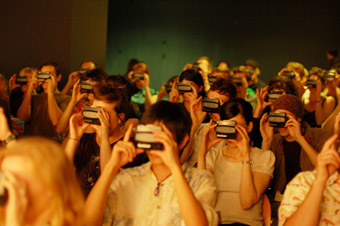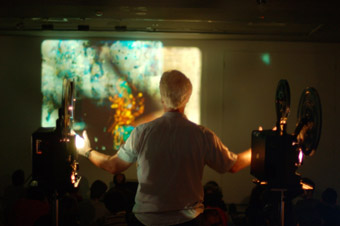beyond play
jim knox at the 2007 otherfilm festival

Vladmaster, OtherFilm Festival 07
photo Christina Tester
Vladmaster, OtherFilm Festival 07
THE MATERIALITY OF FILM IS CENTRAL TO THE CURATORIAL MISSION OF BRISBANE’S OTHERFILM FESTIVAL (OFF). HERE, THE IMMINENT DEFICIENCIES OF THE MEDIUM—ITS BULK, ITS FRAGILITY, ITS INCREASINGLY ANTIQUATED TECHNOLOGIES—ARE RECAST AS POSITIVE ADVANTAGES: WHIMSY, ORGANICISM, NUMINOUSNESS, HISTORICAL CONTEXT. WITHIN A CONTEMPORARY ECONOMICS OF DIGITAL SUPERFLUITY, THE VERY INCONVENIENCE OF FILM REQUIRES, OF NECESSITY, A DISCIPLINE OF ITS CREATORS. NO OTHER MEDIUM DEMANDS AS MUCH RESORT TO COMPLEX FORMULAE RELATED TO LIGHT, DISTANCE, TIME AND CHEMISTRY: DESPITE THE EVANESCENCE OF THE PROJECTED IMAGE, NO OTHER MEDIUM CAN ADVANCE THE CONCEIT THAT IT EMBODIES THE PHYSICAL UNIVERSE UPON SO COMPLETE A SCALE.
Of course, film is simply a medium: the indispensable tools for any artist are intelligence and imagination. Previous editions of OFF did much more to reconcile analogue and digital technologies, and host accommodations of both narrative and expressly visual cinema. In retreating from this inclusive homogeneity, the OFF curators entertain the risk of indulging a form of romantic steam-train anachronism. While this may not be an unreasonable creative response to the experience of the modern world, it has some evident limitations. For me, the strongest works at OFF were often those that visibly responded to the personal experience of the creator, rather than the historical context of the medium.

Dirk de Bruyn, OtherFilm Festival 07
photo Christina Tester
Dirk de Bruyn, OtherFilm Festival 07
The subject of OFF’s retrospective survey was veteran Melbourne experimentalist Dirk de Bruyn. His work is a striking convulsion of sound and image, and a dedicated engagement with the suburban dislocation of a ‘New Australian’ migrant. Central to his concerns are the limits of language per se; this is an existential enquiry. The hallmarks of these films are a naive sound poetry and the colourful use of optical printing to fracture the spatial contiguity of the screen. The work of this extravagant polyglot, devoted to identity confusion, estrangement from the physical environment and the conflict of native tongue and adopted vernacular, might profitably be compared to the film experiments of Ronaldo Azeredo and other Brazilian concrete poets. OFF’s expansive survey of de Bruyn’s cinema and performance has been elaborated by the publication of a valuable monograph, by the tireless Lienors and Dan Torre, themselves engaged in a revelatory investigation of Australia’s native counter-traditions of animation practice.
Among the several international guests, Bruce McClure (USA) was particularly noteworthy. His work exemplifies the field of ‘Flicker’ minimal cinema; three projectors in tandem showing alternating white and black frames, while the PA throbs to a brut ostinato. From this rudimentary technological premise, McClure is able to essay a compelling experiment in Gestalt psychology by making delicate adjustments to the projector aperture gates, with the delay effects governing the soundtracks. As an auditor, there’s an essential fascination to be derived from the brain’s attempt to transfigure coherent form of this simple stimuli: object relations in the form of grids and patterns, sound-image correlations. Volume is a crucial aspect of this work, and supports the immersive qualities of the enveloping darkness; the soundtrack is pleasingly akin to the most challenging industrial music experiments of Boyd Rice’s NON. Minimalism is rarely to my taste, but McClure is at the pinnacle of his field, and his work amply justifies OFF curator Joel Stern’s continuing interest in this neglected margin of experimental cinema.
In company of fellow curator Sally Golding, Stern also figures as part of the expanded cinema ensemble, Abject Leader. Their newest work makes a studied advance on the colour-separation experiments presented by the Cantrills at the previous year’s Festival. This is another variety of minimalism: an antique portrait filmed and projected through green, red and blue filters, the footage converging on a single portrait-format screen. Better than many theoretical expositions of the same idea, the work perfectly illustrates the uncanny essence of cinema: the ambiguity of a static, human form, but projected by a technology that assumes motion, creating the effect of a perceptible tremble in the frame and features of our protagonist.
Some expanded cinema pieces did employ digital projection technology, though not always to their advantage. The work of Dagi Igarashi and Midori Kawai promised an alchemical scrutiny of an earth-and-water response to primary sound vibrations across an intricately sculptural screen, but the live video feeds were scuppered by the grumbling sub-bass frequencies of their audio rig. A genuine shame: the evocative soundtrack enjoyed only thwarted suggestions of how the work was designed to look.
The following weekend, Rod Cooper and Anthony Magen premiered their new Helmethead duo. Cooper wears the eponymous headgear. The screen atop it presents his occasionally grotesque “mental furniture” (this is the organicism I referred to earlier), as rendered by Magen. Both provide live audio accompaniment from handheld dictaphones—the jarring orchestration of cartoon “boings” and Cooper’s more familiar droning textures. Great fun, if a little long; it’s playful, messy, but sufficiently dynamic to command audience attention. Like de Bruyn, Helmethead describes another kind of idiomatic estrangement; on the evening of the 2007 Federal Election we can barely discern subliminal flashes of Rudd and Howard as they compete for Cooper’s allegiance.
Utopian aspirations come with the territory when you advocate for visionary cinema. While the social behaviour of contemporary Western citizens is increasingly mediated by industrial and commercial concerns, the OtherFilm Festival directs its attentions to the congenial rehabilitation of otherwise unlikely venues. Environment is just another aspect of OFF’s ambitious gesamkunstwerk: this time, it was the baroque arcadia of Brisbane’s Old Museum Building, and the use of the Ahimsa House community centre. This year was also the festival’s first in Melbourne, with work by visiting US artists, Kerry Laitalia and Vladmaster, both given receptions as satellite events to ACMI’s Christian Marclay survey.
Laitalia’s work is an archivist’s reverie; some works, particularly Secure the Shadow…E’er the Substance Fade (1997) convey a genuine minatory thrill. The scores of that film and Out of the Ether (2003) both profit from the influence of George Kuchar on their soundtracking strategies; an atmospheric use of found audio sourced from old lounge LPs (I recognised the Peter Thomas soundtrack for Rampatrouille underneath the second). Vladmaster’s work is an absolute anomaly: the inspired adaptation of the familiar but obsolete Viewmaster toy. The Vladmaster employs a singular erudition in the creation of her crypto-cinematic narratives, handcrafting viewer reels from stereoscopic photographs of her own dioramas. In a hilarious perversion of consumer artefact to singular creative ends, soundtrack cues trigger the serried click of audience interaction.
It is perhaps instructive that the Vladmaster’s ACMI performance enjoyed a full house, while Laitalia’s work at the same venue had a more modest one. Certainly, a younger audience has become more predisposed to interactivity in screen media. But Brisbane’s OtherFilm Festival otherwise eschews what has become one of the dominant tendencies in Australian media art curatorship: an infantilising obsession with play, toys and games. It’s a disturbing trend, driven by commercial expedience and technological determinism, and one which assumes an indifference to distinctions between art, entertainment and utility. While this confusion of categories is arguably the most interesting area of both art and entertainment per se, the danger is that critical rigour might be compromised by the pursuit of innocent recreation.
The 3rd OtherFilm Festival, curators Sally Golding, Joel Stern, Danni Zuvela; Institute of Modern Art, Ahimsa House, Old Museum Building, Brisbane Nov 16-24; ACMI Cinemas, Tapespace, Melbourne Nov 29-30, 2007;www.otherfilm.org
RealTime issue #83 Feb-March 2008 pg. 20






